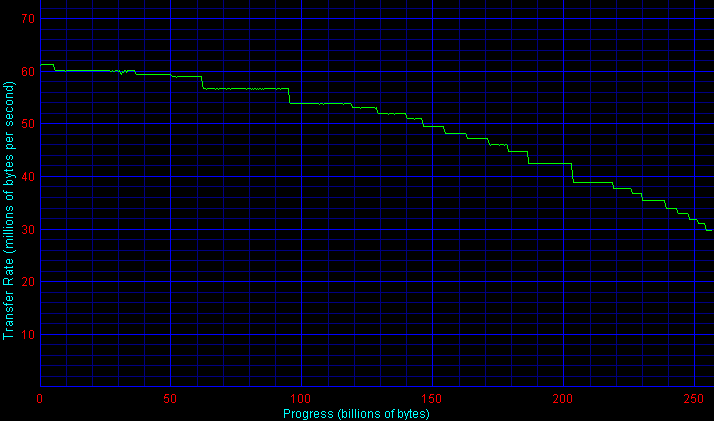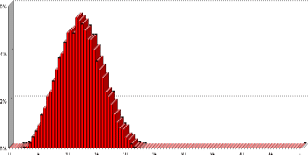|

Since then, IBM sold its famed hard disk division to Japanese conglomerate Hitachi, Ltd. Though Big Blue retains a 30% interest in the division, it is Hitachi, through its Global Storage Technologies division, that oversees day-to-day operations. Taking some time, the transition resulted in a quieting of releases. The Deskstar 180GXP, for example, arrived a bit later than the 60 GB/platter units from the competition. Even so, the 180GXP’s performance and noise levels rivaled that of category leaders.
Over the summer, the 7K250 became the first drive to be announced natively under the new Hitachi name. Like the Western Digital Caviar WD2500 and the Maxtor MaxLine II, the flagship Deskstar 7K250 utilizes three 83-gigabyte platters to achieve a 250 gigabyte capacity. Hitachi specs seek times at 8.5 milliseconds. The 7K250 is available in a wide range of capacities in both parallel and serial ATA interfaces. Both 2- and 8-megabyte buffer sizes are available in the PATA lineup- the smallest drives come only with 2 MB, the flagship with 8 MB, while other sizes available in both. Reflecting the premium market that SATA remains associated with, all serial ATA units come standard with 8 MB of cache. Hitachi warrants 8 MB units for three years; 2 MB drives come with a one-year warranty.
Our sample, an SATA drive, features a newer 15-pin power connector that supports hot-swap functionality. It also, however, includes the legacy 4-pin molex power connector that assemblers have come to love and hate. Either may be used to power the drive.
Like all other designs save only Seagate’s Barracuda series, the 7K250 utilizes an onboard parallel-to-serial bridge. Though converters usually exact a performance penalty, high-level performance remains the ultimate arbiter. All other things being equal, if a bridged design outperforms another that uses a native setup, it should be the obvious choice- as always, it’s bottom-line rather than module-level performance that matters.
The following tests pit the Deskstar 7K250 against other contemporary serial ATA drives. The 10,000 RPM WD Raptor, technically in a different class, appears for reference’s sake. Note that Seagate’s latest available SATA drive is the 80 GB/platter Barracuda 7200.7. Though we have reviewed the 7200.7 in the past, recent driver and BIOS updates forced a retest of all SATA drives. Unfortunately, Seagate has been unable to supply StorageReview with a new sample. Rather than omitting an entry from Seagate entirely, these tests include results from the Barracuda ATA V, a drive that has been retested under updated conditions. Let’s see how Hitachi’s newest stacks up!
Low-Level ResultsFor diagnostic purposes only, StorageReview measures the following low-level parameters: Average Read Access Time– An average of 25,000 random accesses of a single sector each conducted through IPEAK SPT’s AnalyzeDisk suite. The high sample size permits a much more accurate reading than most typical benchmarks deliver and provides an excellent figure with which one may contrast the claimed access time (claimed seek time + the drive spindle speed’s average rotational latency) provided by manufacturers. WB99 Disk/Read Transfer Rate – Begin– The sequential transfer rate attained by the outermost zones in the hard disk. The figure typically represents the highest sustained transfer rate a drive delivers. WB99 Disk/Read Transfer Rate – End– The sequential transfer rate attained by the innermost zones in the hard disk. The figure typically represents the lowest sustained transfer rate a drive delivers. |
For more information, please click here.
|
Note: Scores on top are better. |
|
||||||||||||||||||
|
|
|||||||||||||||||
Hitachi’s drive turns in an impressive access time of just 12.1 milliseconds. Factoring in the 4.2 ms that represents a 7200 RPM spindle speed’s average rotational latency, the drive’s measured seek time weighs in at a lively 7.9 milliseconds and easily beats the firm’s 8.5 ms claim.
|
Note: Scores on top are better. |
|
|||||||||||||||||||||||||||||||||
|
|
||||||||||||||||||||||||||||||||
Hitachi Deskstar 7K250 Transfer Rate
|
|||||||||||||||||||||||||||||||||
Like virtually all other 80 GB/platter disks, the Deskstar manages to deliver about 60 MB/sec in its outermost zones. Transfer rates decay slightly more than the competition, bottoming out at 33 MB/sec.
Single-User PerformanceStorageReview uses the following tests to assess non-server use: StorageReview.com Office DriveMark 2002– A capture of 30 minutes of actual computer productivity use that exactingly recreates a typical office-style multitasking environment. The applications include: Outlook XP, Word XP, Excel XP, PowerPoint XP, Calypso (a freeware e-mail client), SecureCRT v3.3 (a telnet/SSH client), CuteFTP Pro v1.0 (an FTP/SSH client), ICQ 2000b), Palm Hotsync 4.0, Gravity 2.3 (a Usenet/newsgroups client), PaintShop Pro v7.0, Media Player v8 for the occasional MP3, and Internet Explorer 6.0. StorageReview.com High-End DriveMark 2002– A capture of VeriTest’s Content Creation Winstone 2001 suite. Applications include Adobe Photoshop v5.5, Adobe Premiere v5.1, Macromedia Director v8.0, Macromedia Dreamweaver v3.0, Netscape Navigator v4.73, and Sonic Foundry Sound Forge v4.5. Unlike typical productivity applications, high-end audio- and video- editing programs are run in a more serial and less multitasked manner. The High-End DriveMark includes significantly more sequential transfers and write (as opposed to read) operations. |
StorageReview.com Bootup DriveMark 2002– A capture of the rather unusual Windows XP bootup process. Windows XP’s boot procedure involves significantly different access patterns and queue depths than those found in other disk accesses. This test recreates Windows XP’s bootup from the initial bootstrap load all the way to initialization and loading of the following memory-resident utilities: Dimension4 (a time synchronizer), Norton Antivirus 2002 AutoProtect, Palm Hotsync v4.0, and ICQ 2000b.
StorageReview.com Gaming DriveMark 2002– A weighted average of the disk accesses featured in five popular PC games: Lionhead’s Black & White v1.1, Valve’s Half-Life: Counterstrike v1.3, Blizzard’s Diablo 2: Lord of Destruction v1.09b, Maxis’s The Sims: House Party v1.0, and Epic’s Unreal Tournament v4.36. Games, of course, are not multitasked- all five titles were run in a serial fashion featuring approximately half an hour of play time per game.
For more information, please click here.
|
Note: Scores on top are better. |
The Deskstar 7K250 achieves an SR Office DriveMark 2002 of 459 I/Os per second, the first significant improvement in 7200 RPM performance in over a year. Hitachi easily bests Western Digital’s Caviar by a 10% margin and comes within 5% of WD’s 10,000 RPM Raptor.
Hitachi’s results are also impressive in the SR High-End DriveMark, a suite slightly more dependent on sequential transfer rates. Though its 442 I/Os per second commands a slimmer 5% lead over the Caviar, it nonetheless remains in fighting distance with the Raptor and again sets a new 7200 RPM record.
In the SR Bootup DriveMark, a somewhat unusual case that features the higher-than-normal queue depths generated by Windows XP’s boot process, the 7K250 stumbles ever so slightly behind the Caviar by an imperceptible 1% margin.
Finally, in the SR Gaming DriveMark, the Hitachi again opens up a commanding lead over the competition and even matches the Raptor’s score.
Multi-User PerformanceStorageReview uses the following tests to assess server performance: StorageReview.com File Server DriveMark 2002– A mix of synthetically-created reads and writes through IOMeter that attempts to model the heavily random access that a dedicated file server experiences. Individual tests are run under loads with 1 I/O, 4 I/Os, 16 I/Os, and 64 I/Os outstanding. The Server DriveMark is a convenient at-a-glance figure derived from the weighted average of results obtained from the four different loads. StorageReview.com Web Server DriveMark 2002– A mix of synthetically-created reads through IOMeter that attempts to model the heavily random access that a dedicated web server experiences. Individual tests are run under loads with 1 I/O, 4 I/Os, 16 I/Os, and 64 I/Os outstanding. The Server DriveMark is a convenient at-a-glance figure derived from the weighted average of results obtained from the four different loads. For more information click here. |
|
Note: Scores on top are better. |
|
|||||||||||||||||||||||||||||||||
|
|
||||||||||||||||||||||||||||||||
Strangely enough, despite its superior access time, the Deskstar 7K250 does not open up much of a lead over the competition in the File Server DriveMark, a combination of reads and writes in a two-to-one ratio. In the read-only Web Server DriveMark, however, the Hitachi races ahead and breaks the 140 IO/sec mark.
Though these results hint at (relatively) weak write performance, the 7K250’s write prowess in some rudimentary diagnostics is no worse than other drives. We’re not quite sure why the drive fails to chart new territory in the File Server DriveMark. Even so, however, it remains no slouch.
Legacy PerformanceeTesting Lab’s WinBench 99 Disk WinMark tests are benchmarks that attempt to measure desktop performance through a rather dated recording of high-level applications. Despite their age, the Disk WinMarks are somewhat of an industry standard. The following results serve only as a reference; SR does not factor them into final judgments and recommends that readers do the same. |
|
Note: Scores on top are better. |
|
|||||||||||||||||||||||||||||||||
|
|
||||||||||||||||||||||||||||||||
Heat and NoiseIdle Noise– The sound pressure emitted from a drive measured at a distance of 18 millimeters. The close-field measurement allows for increased resolution between drive sound pressures and eliminates interactions from outside environmental noise. Note that while the measurement is an A-weighted decibel score that weighs frequencies in proportion to human ear sensitivity, a low score does not necessarily predict whether or not a drive will exhibit a high-pitch whine that some may find intrusive. Conversely, a high score does not necessarily indicate that the drive exhibits an intrusive noise envelope. Net Drive Temperature– The highest temperature recorded from a 16-point sample of a drive’s top plate after it has been under heavy load for 80 minutes. The figures provided are net temperatures representing the difference between the measured drive temperature and ambient temperature. For more information, please click here. |
|
Note: Scores on top are better. |
|
|||||||||||||||||||||||||||
|
|
||||||||||||||||||||||||||
Thanks to its FDB motors, the Deskstar 7K250 delivers an impressively low idle-noise floor of just 41.5 dB/A, well below the audible threshold of all but the quietest computers. As a three-platter design featuring 12 millisecond access times, however, seek noises are slightly louder than those delivered by the competition… though still much quieter than the Raptor and other 10k/15k SCSI units.
Also likely due to its swift seeks, the Deskstar operates slightly warmer than most other 7200 RPM drives. It should nonetheless easily integrate into systems featuring adequate ventilation and cooling.
ReliabilityThe StorageReview.com Reliability Survey aims to amalgamate individual reader experiences with various hard disks into a comprehensive warehouse of information from which meaningful results may be extracted. A multiple-layer filter sifts through collected data, silently omitting questionable results or results from questionable participants. A proprietary analysis engine then processes the qualified dataset. SR presents results to readers through a percentile ranking system. According to filtered and analyzed data collected from participating StorageReview.com readers, the |
According to filtered and analyzed data collected from participating StorageReview.com readers, a predecessor of the
Hitachi Deskstar 7K250, the
IBM Deskstar 180GXP
, is more reliable than of the other drives in the survey that meet a certain minimum floor of participation.
Note that the percentages in bold above may change as more information continues to be collected and analyzed. For more information, to input your experience with these and/or other drives, and to view comprehensive results, please visit the SR Drive Reliability Survey.
ConclusionCombining the first significant performance increase in over a year with whisper-quiet operation, Hitachi’s Deskstar 7K250 proves that there’s a lot of life left in the venerable 7200 RPM design. Western Digital’s three-year run with the 7200 RPM ATA title has finally come to a close. Available across a wide range of capacities in both parallel and serial ATA interfaces, the 7K250 should top the list of all performance-oriented users seeking a new drive for their desktop rig. Hitachi has easily managed to impress. We look forward to seeing what’s next! |






 Amazon
Amazon